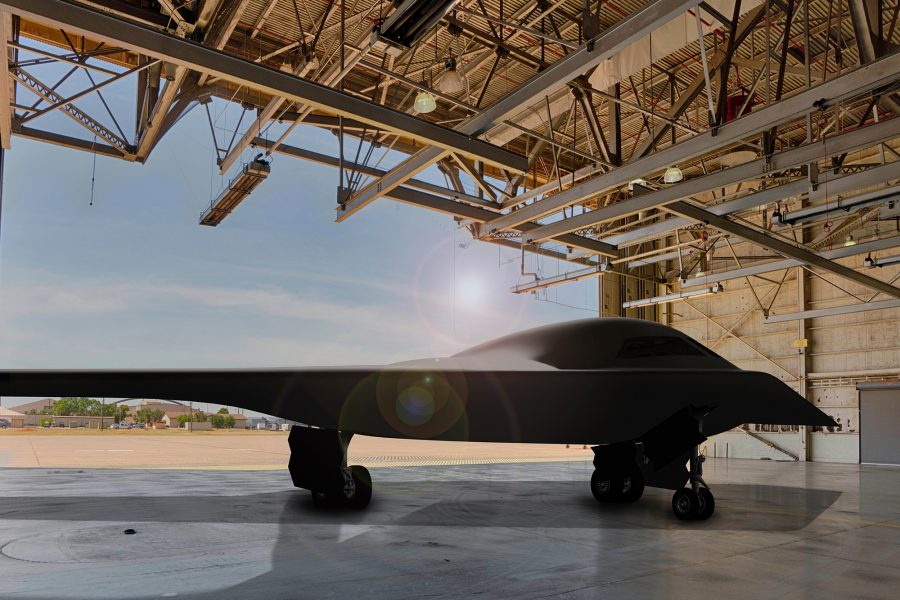Days before the first B-21 Raider is set to emerge from Northrop Grumman’s Palmdale, Calif., factory, the company revealed new details about the seven-year-old, largely classified bomber program. Northrop described complementary elements of the B-21 “family of systems”; confirmed a “digital twin” version of the aircraft; and, in a break with previous programs, eliminated the “block upgrade” approach to modernization.
The airplane is due to roll out of Plant 42 on Dec. 2, with its first flight forecast in mid-2023.
The bomber “has … been designed as the lead component of a larger family of systems that will deliver intelligence, surveillance and reconnaissance, electronic attack and multi-domain networking capabilities,” the company said in a Nov. 29 release.
The statement confirms that the B-21—which Northrop Grumman describes as a “sixth-generation” combat aircraft—will rely on external support platforms or systems, although whether these are escort aircraft, bomber-launched vehicles, satellites, or some other technology is unclear. In recent months, Air Force officials have begun describing the B-21 as an ISR node deep within enemy-controlled airspace.
Air Force Secretary Frank Kendall recently announced he was abandoning plans to develop autonomous, long-range, collaborative combat aircraft meant to escort the B-21 deep into enemy territory, but that did not rule out the bomber launching decoys, jamming vehicles, or ISR-collecting drones.
The company said it has successfully demonstrated migration of B-21 ground systems data to “a cloud environment.” This demonstration included “the B-21 digital twin, that will support B-21 operations and sustainment. This robust cloud-based digital infrastructure will result in a more maintainable and sustainable aircraft with lower-cost infrastructure.”
A “digital twin” is a finely detailed digital model of a system that allows changes—and their ramifications—to be explored by engineers with far greater fidelity and speed than were possible using older design and development technology.
Because it has an open architecture, the B-21 will forego the usual pattern of block upgrades, Northrop Grumman noted.
“To meet the evolving threat environment, the B-21 has been designed from day one for rapid upgradeability,” the company said. “Unlike earlier generation aircraft, the B-21 will not undergo block upgrades. New technology, capabilities and weapons will be seamlessly incorporated through agile software upgrades and built-in hardware flexibility. This will ensure the B-21 Raider can continuously meet the evolving threat head on for decades to come.”
The statement added that, as a “digital bomber,” the B-21 “uses agile software development, advanced manufacturing techniques and digital engineering tools to help mitigate production risk” and “enable modern sustainment practices.”
The company said maintainability was set as “an equally important requirement to stealth performance” at the beginning of the program; and “long-term operations and sustainment affordability [have] been a B-21 program priority from the start,” the company said. Working collaboratively on maintainability with the Air Force, the company said it’s “driving more affordable, predictable operations and sustainment outcomes.” There are six examples of the B-21 in various stages of construction, the company noted.
Northrop Grumman described the B-21 as a “sixth-generation” aircraft, a term which has yet to be clearly defined. A fifth-generation aircraft employs a high degree of stealth in all aspects, and sensor fusion for a high degree of situational awareness.
Various descriptions of “sixth generation” circulating in industry would improve on that by adding an “optionally manned” capability—which the B-21 is meant to have—even better situational awareness, better stealth, and, potentially, use of directed-energy weapons, among other possible attributes.
On stealth, the company said it’s applying “continuously advancing technology, employing new manufacturing techniques and materials to ensure the B-21 will defeat the anti-access, area-denial systems it will face.”
The B-21 “benefits from more than three decades of strike and stealth technology,” the company said, referring to its work on the B-2 Spirit bomber, the YF-23 fighter prototype, the Tacit Blue stealth demonstrator, the AGM-137 Tri-Service Standoff Missile, and presumed numerous classified programs.
“It is the next evolution of the Air Force strategic bomber fleet,” Northrop Grumman asserted, describing the B-21 as a “visible and flexible deterrent.”
Developed “with the next generation of stealth technology, advanced networking capabilities and an open systems architecture, the B-21 is optimized for the high-end threat environment. It will play a critical role in helping the Air Force meet its most complex missions.”
The Raider “will provide the Air Force with long range, high survivability and mission payload flexibility. The B-21 will penetrate the toughest defenses for precision strikes anywhere in the world,” crucial for demonstrating the nation’s “resolve.” It will give regional commanders the “ability to hold any target, anywhere in the world at risk.”
Calling the B-21 the “backbone of the future for U.S. airpower,” Northrop Grumman said the B-21 will “deliver a new era of capability and flexibility through advanced integration of data, sensors and weapons. Capable of delivering both conventional and nuclear payloads, the B-21 will be one of the most effective aircraft in the sky, with the ability to use a broad mix of stand-off and direct attack munitions.”
Northrop Grumman said it has built a supplier base of 400 companies “across 40 states,” comprising a “nationwide team” of 8,000 people “from Northrop Grumman, industry partners and the Air Force.”
The company noted that the B-21 was named “Raider” to commemorate the B-25 Doolittle raiders that bombed Japan early in WWII.
“The actions of these 80 volunteers were instrumental in shifting momentum in the Pacific theater,” and the mission served as a “catalyst to a multitude” of future achievements “in U.S. air superiority from land or sea.”
